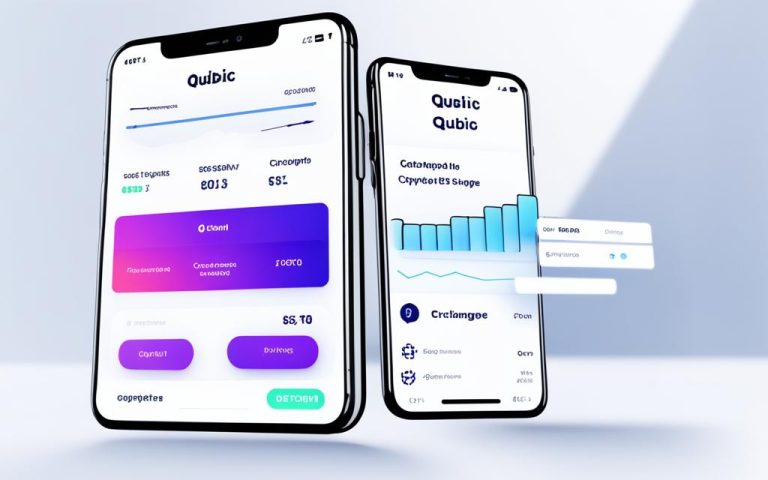DEX coins, or decentralized exchange coins, mean money made for decentralized exchanges (DEXs). These platforms let users trade directly without needing a middleman like a bank. DEX coins have grown key in crypto, supporting new trading ways and more user independence.
They are crucial for adding funds to DEX platforms, making trading smooth. With these coins, people can also help make exchange decisions.
Decentralized exchanges change the game by skipping central authorities. Smart contracts make trades happen on their own, keeping things open and safe for everyone.
To dive deeper into decentralized exchanges, see CryptoSlate’s guide on DEXs. For detailed information on DEX coins, including their value and market moves, check out Crypto.com’s DEX section and CoinRanking’s DEX page.
How Do DEXs Work?
Decentralized exchanges (DEXs) are changing how we trade cryptocurrency. They use smart contracts for peer-to-peer trading, avoiding middlemen. This makes trading direct and efficient.
To make a trade, a user sends their cryptocurrency to a smart contract. This contract holds the assets securely until the trade happens.
The smart contract matches buyers and sellers automatically. It checks if the assets are there and makes the trade when conditions are right. This cuts out the need for people in the middle and makes trading transparent and quick.
DEXs have web interfaces, making it easy for users to start trading. Some also offer desktop or mobile apps for trading on different devices.
Trading on DEXs is mostly between cryptocurrencies. Trading with fiat money might need an extra step, like using a centralized exchange.
Remember, DEXs charge fees for trades and using smart contracts. These fees can vary and go to the protocol, liquidity providers, or token holders. Examples include trading, withdrawal, and blockchain transaction fees.
Advantages of DEXs
DEXs have several benefits over regular exchanges:
- They offer clear, verifiable transactions since everything is on the blockchain.
- Their use of smart contracts makes trades safer and prevents mistakes and manipulation.
- By cutting out central authorities, DEXs reduce the risk of hacking and theft.
- DEXs make trading accessible to more people by allowing them to use their own wallets and an internet connection.
Risks Associated with DEXs
Even with their benefits, DEXs have some risks:
- Their reliance on smart contracts means a flaw could be exploited.
- Some may not have enough trading volume, affecting prices and options.
- Others might face the risk of frontrunning, where people unfairly trade ahead.
- Despite aiming for decentralization, some aspects of DEXs may still be centralised.
Despite the risks, DEXs are growing fast. By January 2019, they had only 0.11% of global trade volume. By August 2023, their share jumped to 14%, with more than $40 billion traded monthly. This shows they’re becoming a key part of crypto trading.
As DEXs keep evolving, they’re vital to decentralized finance (DeFi). They offer peer-to-peer trading, more transparency, and open up finance to more people in the digital world.
Sources:
- Learn more about DEXs on Chain.link.
- Explore decentralized exchanges at Gemini’s Cryptopedia.
- Discover the benefits of DEXs on Kriptomat.
Benefits and Risks of DEXs
Decentralized exchanges (DEXs) have many advantages over centralized ones. An important one is how open they are. Users can check each transaction on the blockchain. This reduces risks and builds trust.
Another big plus of DEXs is that users keep control of their money. They trade directly from their wallets without a middleman. This makes transactions safer and makes users feel secure.
DEXs also make more liquidity and financial inclusion. They are open to everyone without a long signup process. This gives people around the world a chance to join in the global finance scene.
However, there are risks with DEXs too. One big risk is smart contract vulnerabilities. DEXs use blockchain protocols which can have bugs or weak spots. These issues can lead to losses. It’s crucial for developers to keep improving their platforms.
DEXs can also have trouble with liquidity, especially in smaller markets. They depend on users to create the market. So, some markets might not have enough trading or liquidity.
Sometimes DEXs might not be fully decentralized. Some may have centralized points, like servers or access to smart contracts. Although DEXs try to share control, one should still assess how decentralized a platform really is.
In closing, decentralized exchanges offer many benefits such as transparency, control, and access. But, they also have risks. Knowing about smart contract vulnerabilities, liquidity problems, and decentralization limits helps users make better choices. They can confidently step into decentralized finance.
FAQ
What are DEX coins?
DEX coins are digital currencies used on decentralized exchanges. These exchanges allow direct trades between people without middlemen. DEX coins help power decentralized finance (DeFi), leading to innovative trading and more financial control.
How do DEXs work?
DEXs use smart contracts to automate trades. When you send assets to a smart contract, it pairs buy and sell orders. Then, it makes the trade happen on its own.
DEXs can be used on websites, desktops, or mobile apps. They mainly handle crypto-to-crypto trades. For fiat trades, you might need to use a regular exchange. Each platform has different fees for trading and using smart contracts.
What are the benefits and risks of using DEXs?
DEXs make trading transparent and reduce the risk of dealing with others. You control your money directly, without a middleman. They offer lots of trading opportunities and make financial services open to everyone.
But, DEXs aren’t perfect. Issues like smart contract bugs, limited market liquidity, and threats from arbitrageurs exist. Also, some parts of DEXs might still rely on centralized systems or have restricted access.



















